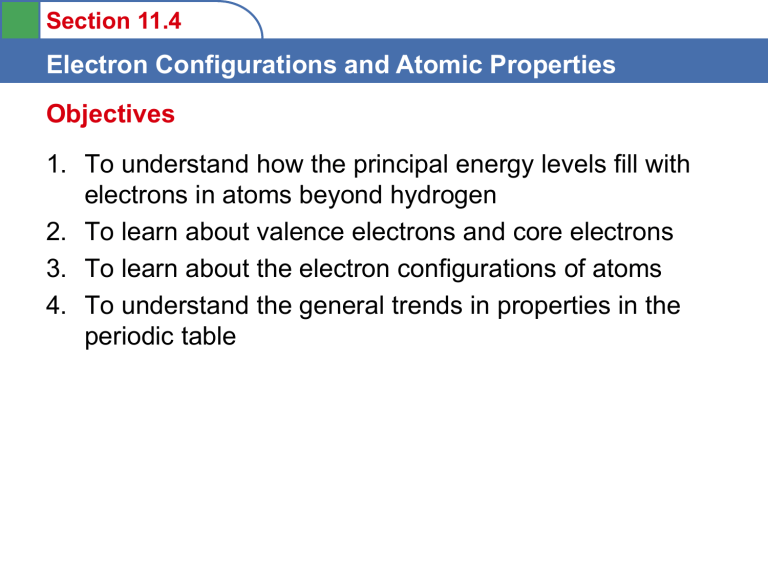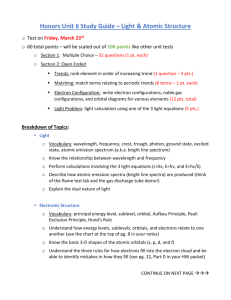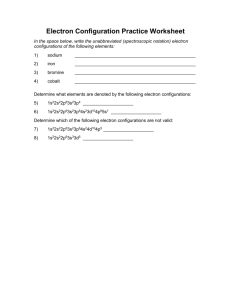Section 11.4 Electron Configurations and

Section 11.4
Electron Configurations and Atomic Properties
Objectives
1. To understand how the principal energy levels fill with electrons in atoms beyond hydrogen
2. To learn about valence electrons and core electrons
3. To learn about the electron configurations of atoms
4. To understand the general trends in properties in the periodic table
Section 11.4
Electron Configurations and Atomic Properties
A. Electron Arrangements in the First 18 Atoms on the
Periodic Table
• H atom
– Electron configuration – electron arrangement – 1 s 1
– Orbital diagram – orbital is represented as a box with a designation according to its sublevel. Contains arrow(s) to represent electrons (spin)
Section 11.4
Electron Configurations and Atomic Properties
A. Electron Arrangements in the First 18 Atoms on the
Periodic Table
• He atom
– Electron configuration – 1 s 2
– Orbital diagram
Section 11.4
Electron Configurations and Atomic Properties
A. Electron Arrangements in the First 18 Atoms on the
Periodic Table
• Li atom
– Electron configuration – 1 s 2 2 s 1
– Orbital diagram
Write the electron configuration and orbital diagrams for Boron,
Nitrogen, Fluorine and Argon
Section 11.4
Electron Configurations and Atomic Properties
A. Electron Arrangements in the First 18 Atoms on the
Periodic Table
Write the full electron configuration of Neon and Sulfur
Draw an orbital diagram for Magnesium and Chlorine
Section 11.4
Electron Configurations and Atomic Properties
A. Electron Arrangements in the First 18 Atoms on the
Periodic Table
Classifying Electrons
• Valence electrons – electrons in the outermost (highest) principal energy level of an atom
• Core electrons – inner electrons
• Elements with the same valence electron arrangement
(same group) show very similar chemical behavior.
Section 11.4
Electron Configurations and Atomic Properties
B. Electron Configurations and the Periodic Table
• Electron configurations for K through Kr
Section 11.4
Electron Configurations and Atomic Properties
Using a Noble Gas Shorthand
• We can abbreviate electron configurations by using the configuration of the previous noble gas to cover the first part of the list of orbitals
• Mg is 1s 2 2s 2 2p 6 3s 2 or [Ne] 3s 2
• The noble gas portion is the equivalent to the group of core electrons
• Use the Noble Gas shorthand to show the electron configurations of Carbon and Zirconium
Section 11.4
Electron Configurations and Atomic Properties
Order of Filling of Orbitals
Atoms fill their orbitals in the order of their energies:
Section 11.4
Electron Configurations and Atomic Properties
B. Electron Configurations and the Periodic Table
• Orbital filling and the periodic table
Section 11.4
Electron Configurations and Atomic Properties
B. Electron Configurations and the Periodic Table
Section 11.4
Electron Configurations and Atomic Properties
C. Atomic Properties and the Periodic Table
Metals and Nonmetals
• Metals tend to lose electrons to form positive ions.
• Nonmetals tend to gain electrons to form negative ions.
Section 11.4
Electron Configurations and Atomic Properties
C. Atomic Properties and the Periodic Table
Atomic Size
• Size tends to increase down a column.
• Size tends to decrease across a row.
(close to scale)
Section 11.4
Electron Configurations and Atomic Properties
C. Atomic Properties and the Periodic Table
Ionization Energies
• Ionization Energy – energy (ΔH) required to remove an electron from an individual atom (gas)
– Tends to decrease down a column
– Tends to increase across a row
– Changes in an opposite direction to atomic size
Section 11.4
Electron Configurations and Atomic Properties
Ionization Energies
Section 11.4
Electron Configurations and Atomic Properties
Electron Affinity
• Electron Affinity is defined as ΔH for the process:
X
(g)
+ e = X
(g)
-
ΔH = Electron Affinity
Section 11.4
Electron Configurations and Atomic Properties
Electronegativity
• Ionization Energy and
Electron Affinity are combined to give
Electronegativity – a measure of how well atoms compete for electrons in a bond




